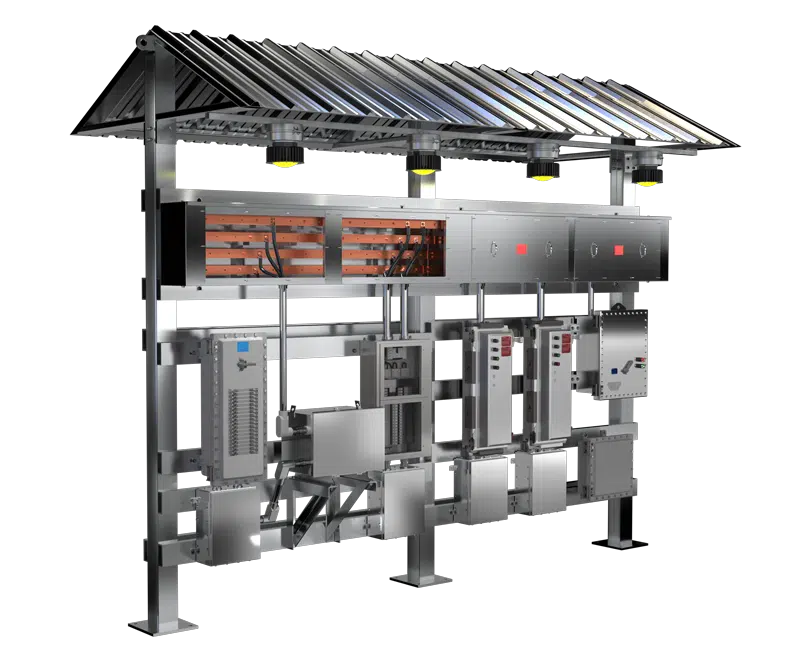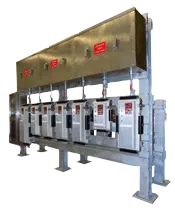
In today’s highly competitive petrochemical and industrial markets, return on investment (ROI) is critically dependent on how quickly and efficiently projects can be completed and operationalized. Switchracks, particularly those designed for hazardous locations (HazLoc), offer distinctive advantages over traditional substations and modular buildings, significantly enhancing financial returns through faster project timelines, lower total installed costs, and exceptional scalability for future growth. Drawing upon comprehensive IEEE guidelines and leveraging real-world solutions from industry leaders like Spike Electric Controls, this blog explores the strategic pathways through which HazLoc switchracks maximize ROI.
Accelerated Project Delivery
Time-to-market is a critical metric in any industrial or petrochemical facility project. According to IEEE industry insights, typical project timelines from design approval to commissioning are notably shorter for switchracks compared to traditional solutions. While conventional substation projects commonly stretch from 12 to 24 months, switchracks consistently reduce this timeframe to approximately three to six months, delivering considerable competitive advantage.
Spike Electric Controls optimizes these timelines through extensive pre-engineering and robust factory acceptance testing. Each switchrack leaves the factory fully integrated, rigorously tested, and ready for rapid field installation, significantly compressing onsite work schedules. By transferring extensive engineering, procurement, and assembly activities to a controlled factory environment, Spike Electric mitigates common project risks such as field coordination errors, equipment mismatch, and scheduling delays.
Cost Efficiency from Factory-to-Field
Cost control begins long before equipment arrives on site. HazLoc switchracks reduce expenses by streamlining design and eliminating extensive onsite installation labor, costly errors, and project disruptions. IEEE emphasizes that switchracks minimize field-erection complexity by shifting substantial electrical and mechanical assembly work to the factory floor.
With traditional substations or modular buildings, multiple components such as motor control centers, transformers, panelboards, and protective devices are shipped individually, requiring extensive onsite integration and coordination. In contrast, Spike Electric delivers fully assembled and tested switchracks that require minimal onsite connections, substantially cutting back labor costs and installation man-hours—often by a factor of two to four times compared to conventional substations.
Moreover, reduced space requirements contribute significantly to lowering overall project costs. IEEE data reveals that HazLoc switchracks require considerably less real estate—often as little as 200 square feet compared to several thousand square feet required by traditional substations. This smaller footprint not only reduces upfront real estate expenditures but also minimizes ongoing maintenance and operational costs.
Built-In Flexibility for Expansion
Facilities rarely remain static; expansions, upgrades, or modifications are often inevitable. Recognizing this reality, IEEE guidelines strongly recommend designing electrical infrastructure for maximum flexibility. HazLoc switchracks excel in this regard by providing inherent scalability, significantly simplifying future expansions.
Switchracks from Spike Electric Controls typically incorporate modular designs with extendable bus systems, allowing seamless integration of additional circuits, starters, or transformers without significant downtime or structural changes. This modularity ensures that switchracks grow with operational demands, easily accommodating new electrical loads introduced by process enhancements or capacity expansions.
By contrast, traditional substations require extensive pre-planning and significant upfront investment in infrastructure to accommodate future capacity—often leading to unnecessary expenditures if planned expansions do not materialize as forecasted. Switchrack installations eliminate such speculative spending, ensuring investments align closely with actual operational needs.
Innovation and New Technology
Innovation in hazardous location equipment further amplifies the benefits of switchracks. Technologies such as Eaton’s EBMX clamped enclosures and SynergEX stainless encapsulated panel boards exemplify the cutting-edge advancements that Spike Electric integrates into their designs:
- EBMX Clamped Enclosures: Eaton’s EBMX series provides explosion-proof circuit breakers specifically designed for hazardous environments, delivering exceptional safety and durability. These robust enclosures feature clamped covers for rapid, tool-free access, significantly reducing downtime during inspections or maintenance activities. Their advanced sealing technology offers superior protection against explosive atmospheres, ensuring reliable operation even under the harshest conditions. Clamped EBMXB Explosionproof Circuit Breakers | Crouse-Hinds series | Eaton
- SynergEX Encapsulated Panel Boards: The SynergEX encapsulated hazardous area lighting and heat-tracing panels from Eaton offer unmatched performance in Class I, Division 2 environments. These stainless steel, encapsulated panel boards are fully sealed, ensuring protection against moisture, corrosion, and explosive vapors. The encapsulation technology enhances reliability, extends product life, and reduces maintenance requirements, further minimizing operational interruptions and enhancing safety. SynergEX EZFlex Encapsulated Hazardous Area Panelboards | Crouse-Hinds series | Eaton
Integrating these advanced solutions into Spike Electric Controls’ HazLoc switchrack designs not only bolsters operational reliability but also simplifies compliance with increasingly stringent safety regulations.
Enhanced Flexibility for Future Expansion
A significant advantage of HazLoc switchracks, emphasized by IEEE standards, is their inherent flexibility for future expansions. Unlike conventional substations, which often require extensive modifications or new construction to accommodate additional loads or equipment, switchracks are specifically engineered for modular and incremental growth:
- Modular Design: Switchracks are typically constructed with open-frame or skid-mounted modular configurations, designed explicitly to accommodate additional modules, circuit breakers, motor starters, and control equipment. Spike Electric’s modular switchrack systems allow units to be shipped as fully assembled and tested sections, ensuring simplified logistics and faster installation. This modular approach drastically reduces both time and costs associated with future capacity expansions, as additional sections can be seamlessly integrated without extensive downtime or operational disruptions.
- Bus Extension Capabilities: IEEE guidelines highlight the importance of designing switchracks with easily extendable bus systems. Spike Electric designs its bus duct systems to enable straightforward extensions, offering robust copper or aluminum bus bars that can be readily expanded in the field. This ensures minimal operational disruption when adding new electrical loads or integrating new process equipment, significantly enhancing operational flexibility and scalability.
- Scalable Skid Systems: Spike Electric’s modular switchrack solutions incorporate scalable skid-mounted designs, offering enhanced portability and configurability. Each skid can be pre-equipped with specific configurations of distribution equipment and protective devices, facilitating quick reconfiguration as operational needs evolve. The skid-based approach simplifies relocation, upgrades, and integration with existing facilities, ensuring that the electrical infrastructure remains adaptable to future operational changes without the need for extensive construction or additional site preparation.
- Interchangeability of Components: To further enhance flexibility, Spike Electric ensures component interchangeability across modular switchrack systems. Standardized components and connectors facilitate quick replacement and upgrades, enabling facilities to efficiently adapt their infrastructure to meet evolving operational requirements or new technological advances.
This thoughtful modular engineering not only aligns with IEEE best practices but also strategically positions facilities to easily respond to future growth opportunities, evolving technological advancements, and dynamic market demands, ensuring maximum long-term return on investment.
Improved Environmental and Safety Performance
Environmental compliance and operational safety are paramount concerns for hazardous locations. IEEE standards articulate clear requirements for designing switchracks that minimize environmental impact and maximize worker safety.
Spike Electric Controls integrates IEEE-recommended safety features such as comprehensive grounding systems, clearly defined arc-flash boundaries, and precise protective device coordination. These measures significantly reduce incident risks, preventing potentially catastrophic outcomes that could lead to facility shutdowns, regulatory fines, or serious worker injuries.
Furthermore, by significantly shrinking the physical footprint required for power distribution infrastructure, HazLoc switchracks minimize site disruption, reducing environmental permitting complexity and associated costs. These reduced requirements help streamline regulatory approvals, accelerate project timelines, and lower overall environmental management expenses.
Strategic Benefits of Single-Source Turnkey Solutions
Choosing a single-source turnkey supplier like Spike Electric Controls delivers additional strategic ROI benefits. Consolidating engineering, manufacturing, installation oversight, and maintenance under a single expert entity greatly simplifies project execution and risk management.
Turnkey providers offer clearly defined accountability, ensuring quality standards are consistently met across every project phase. Simplified procurement processes, fewer vendor interactions, and more predictable scheduling further reduce administrative overheads and coordination costs.
Additionally, turnkey suppliers proactively identify efficiencies and cost-saving opportunities throughout the project lifecycle. Spike Electric Controls, for example, continually leverages industry experience and IEEE standards to optimize design decisions, streamline component selection, and maximize long-term asset performance.
Sustaining Competitive Advantage with IEEE-Backed Solutions
Petrochemical facilities that invest strategically in HazLoc switchracks achieve lasting competitive advantages through faster project completions, lower operational costs, enhanced flexibility, improved reliability, and exceptional safety performance. Each of these benefits directly enhances ROI, positioning organizations for sustained operational excellence and growth.
Leveraging IEEE-backed engineering methodologies and real-world expertise from industry leaders like Spike Electric Controls ensures HazLoc switchracks consistently deliver these strategic outcomes. By carefully aligning design practices, installation methods, and operational management with IEEE guidelines, companies not only achieve immediate cost savings and rapid payback periods but also create robust infrastructure capable of evolving with future market demands.
Conclusion: Realizing the Maximum ROI Potential of HazLoc Switchracks
In conclusion, maximizing ROI through HazLoc switchracks is not simply about upfront savings; it is about creating a sustainable infrastructure strategy that delivers ongoing operational benefits across the entire asset lifecycle. By adhering rigorously to IEEE standards and employing the extensive practical experience of suppliers like Spike Electric Controls, petrochemical operators significantly accelerate time-to-market, reduce total installed and lifecycle costs, and build scalable, highly reliable electrical infrastructure.
Investing in HazLoc switchracks is thus a strategic decision—one that not only improves immediate project economics but also positions organizations for sustained competitive advantage, financial growth, and long-term operational success.


